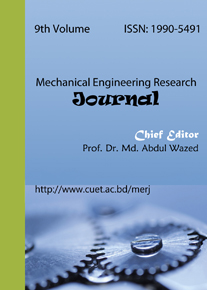Instructions for Authors
i. Submission of Manuscript
Manuscripts should be submitted electronically through the e-mail to merjvol.13@gmail.com in the form of a single file containing the following materials in the order shown.
(1) Title, Authors, Affiliations, Corresponding author E-mail, Abstract, Keywords
(2) Main text of the manuscript
(3) Acknowledgments and References
(4) Table captions and Tables, Figure captions and Figures.
Prior publications: Submission of a paper implies that it has not previously been published in a journal and it is not being simultaneously considered for publication elsewhere.
ii. Preparation of Manuscripts
The language of the journal is English. The manuscript should be typewritten in single column, double-spaced with wide margins, and with 12pt size Times New Roman font using Microsoft Word. The manuscript should be prepared in A4-sized pages (210 x 297 mm) with top, left and right margins of 30 mm and bottom margin of 25 mm. All pages should be numbered consecutively starting from the title page. The length of the manuscript should be the minimum necessary for clarity.
TITLE: Title should be carefully chosen to indicate as clearly as possible the contents of the paper with all upper case, bold and centered and 14pt size.
Author’s names and Affiliations: The name(s) of the author(s) should appear below the title in boldface uppercase and lowercase letters (e.g. M. A. Islam). The font size for author(s) name, affiliation(s) is 11pt Times New Roman font and centered.
Indicate all affiliations with a lower-case superscript letter immediately after the author's name. Affiliations should include the following information in the order of Department/School, Institute/University, City, Zip Code, Country.
At least one corresponding author along with email address should be provided who is willing to handle correspondence at all stages of refereeing, publication and also post-publication.
ABSTRACT: The abstract should not exceed 200 words. Abstract will include a summary of the objective, method, findings, and conclusion.
KEYWORDS: Immediately after the abstract, provide a maximum of 6 words (italic).
NOMENCLATURE: List of notations where applicable.
TEXT: In the introduction part author should provide a clear statement of the problem, the relevant literature on the subject, and the proposed approach or solution. Materials and Methods should be complete enough to allow experiments to be reproduced. Results and discussion should be presented with clarity and precision. Conclusions should clearly explain the main conclusions of the work highlighting its importance and relevance.
Subdivision of the article: Divide your article into clearly defined and numbered sections. Subsections should be numbered 1, 2. (then 1.1, 1.1.1, 1.1.2, etc) and should be typed on a separate line and should not be underlined. Sub headings should be typed with boldface uppercase and lowercase letters.
Units: Only recommended SI units should be used, where as other units could be used in the parentheses. The manuscript should be self-consistent as to mathematical symbols should be properly defined.
Equations: All equations should be clearly typewritten using Microsoft Equation. Equations should be numbered consecutively throughout the text with numerals in parentheses such as (1), (2), and (3), etc. and flush them to the right margin. Equations should be referred to within the text as follows Eq. (1), Eqs. (2)-(4), etc. except at the beginning of a sentence ‘Equation’ is not abbreviation.
Tables: Tables must be numbered consecutively along with a brief title. The number of the table should be cited in the text.
Figures: Figures include diagrams, pictures and charts should be numbered consecutively in the manner Fig. 1, Figs. 2(a) and 2(b), etc. Preferred file types: TIFF, JPEG, EPS, PDS format. For manuscripts in the revision stage, adequate figure resolution is essential to a high-quality print. Please note that the article will be published in black and white.
ACKNOWLEDGMENTS:The Acknowledgments of people, grants, funds, etc should be brief
APPENDIX:
REFERENCES:
All references to other papers, proceedings, books, etc. should be given at the end of the paper. They should be indicated in the text by consecutive numbers in third bracket, e.g., [1] or [1,2] or [1-6], as part of the text. References should contain the authors' names together with their initials, the contracted title of the journal, volume number, page number, and year, as illustrated below. References to books should contain the publisher's name and location. For collected works (e.g., conference proceedings), the editors' names should always be cited. Reference to unpublished reports should only be made when no alternative published form can be located. Type all the references in the corresponding format given below:
(a) Journals: Author, “Paper title”, Journal Title, Vol., page, year.
[1] M. K. Hasan, “Development of a position monitoring system for patients”, Mechanical Engineering Research Journal, Vol. 8, pp. 03-08, 2012.
(b) Conference Proceedings or Books:
[2] Y. W. Lee, M. A. M. Hossain, S. T. Hong, Y. J. Yum and K. Y. Park, “Characterization of friction stir spot welding of aluminum alloys using acoustic emissions”, Proceedings of the Twenty-first International Offshore and Polar Engineering Conference, Maui, Hawaii, USA, pp. 527- 530, June 19-24, 2011.
(c) Books:
[3] J. P. Hirth and J. Loathe, Theory of Dislocations, 2nd ed., pp. 764-774, John Wiley & Sons, New York, 1982.
(d) Thesis and Reports: Author, “Title”, page, university, place, year.
[4] K. Park, “Development and analysis of ultrasonic assisted friction stir welding process”, Ph. D. Thesis, pp. 97-116, The University of Michigan, Michigan, 2009.
[5] G. A. Laawrence and J. Imberger, “Selective withdrawal through a point sink in a continuously stratified fluid with pycnocline”, Report No. ED 79-002, Center for Water research, Univ. of Western Australia, 1979.
(e) Web-page: Author, Title, URL (year).
[6] J. Chu, Mechanical engineers develop an ‘intelligent co-pilot’ for cars, 2012. [Online] Available: http://newsoffice.mit.edu/2012/mechanical-engineers-develop-intelligent-car-co-pilot-0713 (July 13, 2012).



